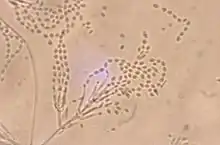Purpureocillium
Purpureocillium is a fungal genus in the Ophiocordycipitaceae family. The genus now contains at least 5 species with the type species Purpureocillium lilacinum, a common saprobic, filamentous fungus.[3] It has been isolated from a wide range of habitats, including cultivated and uncultivated soils, forests, grassland, deserts, estuarine sediments and sewage sludge, and insects. It has also been found in nematode eggs, and occasionally from females of root-knot and cyst nematodes. In addition, it has frequently been detected in the rhizosphere of many crops. The species can grow at a wide range of temperatures – from 8 to 38 °C (46 to 100 °F) for a few isolates, with optimal growth in the range 26 to 30 °C (79 to 86 °F). It also has a wide pH tolerance and can grow on a variety of substrates.[4][5] P. lilacinum has shown promising results for use as a biocontrol agent to control the growth of destructive root-knot nematodes.
| Purpureocillium | |
|---|---|
 | |
| Divergent phialides and long, tangled chains of elliptical conidia borne from more complex fruiting structures characteristic of Purpureocillium lilacinum; magnification 460X. | |
| Scientific classification | |
| Kingdom: | Fungi |
| Division: | Ascomycota |
| Class: | Sordariomycetes |
| Order: | Hypocreales |
| Family: | Ophiocordycipitaceae |
| Genus: | Purpureocillium Luangsa-ard, Hywel-Jones, Houbraken & Samson (2011) |
| Type species | |
| Purpureocillium lilacinum (Thom) Luangsa-ard, Hou- braken, Hywel-Jones & Samson (2011) | |
| Synonyms[1] | |
|
Paecillium Luangsa-ard, Hywel-Jones & Samson nom. prov. (2007)[2] | |
Species and phylogeny

Species fungorum and GBIF currently list:
- Purpureocillium atypicola (Yasuda) Spatafora, Hywel-Jones & Luangsa-ard, 2015
- Purpureocillium lavendulum Perdomo, Dania García, Gené, Cano & Guarro, 2013
- Purpureocillium lilacinum (Thom) Luangsa-ard, Houbraken, Hywel-Jones & Samson, 2011
- Purpureocillium sodanum Papizadeh, Soudi, Wijayaw., Shahz.Faz. & K.D.Hyde, 2016
- Purpureocillium takamizusanense (Kobayasi) S.Ban, Azuma & Hirok.Sato, 2015
- a number of unclassified isolates.
P. lilacinum was previously considered to be monotypic and was classified with the Fungi Imperfecti or Deuteromycetes, fungi for which perfect (i.e., sexually reproducing) states have rarely been found. "Paecilomyces lilacinus" was classified in the section Isarioidea, for which perfect states had not been found. Many isolates of P. lilacinum have been identified from around the world and it is accepted that variation exists within the species. Phylogenetic analysis of P. lilacinum isolates show that it is not related to Trichoderma, Gliocladium and Hypocrea and more related to entomopathogenic genera such as Hirsutella and Ophiocordyceps in the Hypocreales.[6]
References
- "Paecilomyces lilacinus (Thom) Samson 1974". MycoBank. International Mycological Association. Retrieved 2011-07-17.
- Domsch KH, Gams W, Anderson TH, eds. (2007). Compendium of Soil Fungi (2nd ed.). Lubrecht & Cramer Ltd. p. 322. ISBN 978-3-9803083-8-0.
- Spatafora; et al. (2015). "New 1F1N Species Combinations in Ophiocordycipitaceae (Hypocreales)". IMA Fungus. 6 (2): 357–362. doi:10.5598/imafungus.2015.06.02.07. PMC 4681259. PMID 26734546.
- Samson RA. (1974). "Paecilomyces and some allied hyphomycetes". Studies in Mycology. Baarn: Centralbureau voor Schimmelcultures. 6: 58.
- Anderson TH, Domsch KH, Gams W (1995). Compendium of Soil Fungi. Lubrecht & Cramer Ltd. ISBN 3-9803083-8-3.
- Inglis PW, Tigano MS (2006). "Identification and taxonomy of some entomopathogenic Paecilomyces spp. (Ascomycota) isolates using rDNA-ITS Sequences" (PDF). Genetics and Molecular Biology. 29 (1): 132–6. doi:10.1590/s1415-47572006000100025.